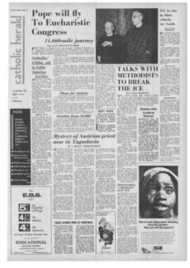Page 7, 24th November 1967
Page 7

Report an error
Noticed an error on this page?If you've noticed an error in this article please click here to report it.
Tags
Share
Related articles
Mixing Peoples Action
From Nicknacks To Neighbours In Children's Books
Memora Ble Reading
Tv And Radio By Tom Castro
Books For The Young
Personalities from the past that rouse a young mind
HISTORY comes across pretty painlessly in biographies, and the child who
doesn't take to abstract ideas may take to personalities from the past instead
For children of about 7-10 there's plenty of interest in
A Selection of New Novels When Marnie Was There
JOAN G. ROBINSON The beautifully told story of a lonely orphan girl's friendship with the elusive Marnie Illustrated by Peggy Fortnum 15s
The Owl Service
ALAN GARNER Illus. 15s
Caldicott Place
NOEL STREATFEILD Illustrated 153
The Wild One
MONICA EDWARDS
Illustrated 13s 6d
The Longhorn Trail
KENNETH ULYATT 16s
Picture Books Preep in Paris
MILTON SHULMAN Pictures by DALE MAXEY Preep, the little pigeon of Trafalgar Square continues his
adventures in Paris 15s
The Nightingale
HANS ANDERSEN Translated by EVA LE GALLIENNE Illustrated in full colour by Nancy Eckholen Burkett 18s
The Paddington Books
MICHAEL BOND
Seven titles are now available at 10s 6d each.
COLLINS
Muller's illustrated "Indian
series" at 15s., true stories about Red Indians that are a very long way from the hackneyed idea of bad-Indians and goodWhites. There's Squanto, Indian Adventurer, who left Massachusetts for England and Spain even before the Pilo irn Fathers landed there; Chief Seattle, Great Statesman, after whom the town was named, a man who today would be btsund to get the Nobel Peace Prize; Crazy Horse, Sioux Warrior, who fought for his people in the eighteen sixties and seventies; and Sacagawea, Indian guide, who married a French trapper and guided explorers up the Missouri, over the Rockies and on to the Pacific.
Another intrepid explorer is Lady Hester Stanhope, Pitts niece and hostess when he was Prime Minister, heroine of Jean Gordon Hughe's Queen of the Desert (Macmillan, 18s.). After Pitt's death she took off for the Middle East and never came back, "the despair of consuls and the admiration of the Turks". This lively. well-illustrated biography does her justice.
Norah Smaridge's Master Mariner (World's Work, 18s.) is a staid. moving biography of Joseph Conrad, concentrating on his early years-the terribly adventurous childhood, spent partly as a political prisoner with his parents in Russia, and the years at sea. By the same author and publisher is The Light Within (16s.), the life of Maria Montessori, whose ideas on education are put across simply but forcefully. Their startling originality at the time, given the gloomy state of schooling, particularly in Italy—the drilling and rules, the learning by rote, the boredom, the competitiveness, the punishments— gives this serious, attractive book a sense of pioneering excitement. When I now read of the marvels of some progressive primary school, I remember how, in the Montessori class I attended in the thirties. we already had the same sort of system and atmosphere and equipment and freedom and fun.
Ian Fellowes Gordon's Famous Scottish Lives (Odhams, 25s.) is a rumbustious, idiosyncratic, journalesey book consisting of biographies of 30 Scots from St. Margaret to Sir Basil Spence, with those you might expect (Bums, Scott, Livingstone, Lauder, Fleming, etc.) in between, and a few you mightn't, like the Queen Mother.
Lastly, for older children— intelligent 10-year-olds on, and certainly teenagers as wellDobson's "People from the past" series at 18s. The two I have are political biographies in a quite mature sense of the word and give a pretty comprehensive idea
of the background of their heroes' lives, demanding a good deal of concentration and making an exciting return for it.
Ronald Seth's Lev Trotsky. the Eternal Rebel straightens out some of the confusion surrounding the fifty-year-old revolution and gives a fair idea both of Trotsky as a man and of the system that pursued him for so many years till the ice-pick at last crashed on his skull in Mexico.
Edgar Holt's Giuseppe Mazzini, the Great Conspirator has an equally complex background --that of Italy in all the upheavals of its 19th century— and deals with it clearly and excitingly. Mazzini was a Londoner by adoption, whose blue plaque you can see on the house where he lived in Gower Street, and his life of highly romantic (as well as effective) conspiracy was spent between the two countries he loved best, using all the pre-Bond arts of espionage— false names and invisible ink.
blog comments powered by Disqus











